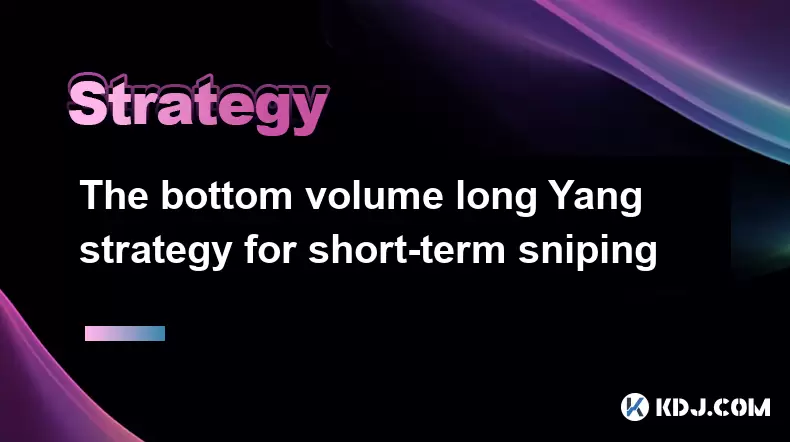-
 bitcoin
bitcoin $120167.907534 USD
1.27% -
 ethereum
ethereum $4468.611945 USD
2.53% -
 xrp
xrp $3.013607 USD
1.80% -
 tether
tether $1.000549 USD
-0.01% -
 bnb
bnb $1092.592149 USD
6.28% -
 solana
solana $231.391244 USD
4.59% -
 usd-coin
usd-coin $0.999699 USD
-0.04% -
 dogecoin
dogecoin $0.259020 USD
4.30% -
 tron
tron $0.342747 USD
0.34% -
 cardano
cardano $0.860977 USD
1.07% -
 hyperliquid
hyperliquid $50.155412 USD
5.34% -
 chainlink
chainlink $22.637678 USD
0.46% -
 ethena-usde
ethena-usde $1.000528 USD
-0.07% -
 avalanche
avalanche $30.613779 USD
-0.07% -
 stellar
stellar $0.403905 USD
0.94%
The bottom volume long Yang strategy for short-term sniping
The bottom volume long Yang strategy helps traders capitalize on short-term crypto price movements by identifying low volume and bullish reversal patterns.
Jun 05, 2025 at 10:56 am

The bottom volume long Yang strategy is a tactical approach used by traders in the cryptocurrency market to identify and capitalize on short-term price movements. This strategy focuses on finding moments when the trading volume is at its lowest and the price action shows signs of a potential bullish reversal, known as a 'long Yang' pattern. In this article, we will delve into the details of this strategy, how to implement it, and the key indicators to watch for successful short-term sniping.
Understanding the Bottom Volume Long Yang Strategy
The core of the bottom volume long Yang strategy lies in identifying periods of low trading volume, which often signal a temporary pause in market activity. During these times, the market may be preparing for a significant move. The 'long Yang' part of the strategy refers to a bullish candlestick pattern, which can indicate the start of an upward trend.
Low volume is crucial because it suggests that fewer traders are actively participating in the market, potentially leading to less resistance against a price increase. When combined with a long Yang pattern, which is a large bullish candle following a period of consolidation or downtrend, it can signal a strong buying opportunity.
Identifying Low Volume Periods
To successfully implement the bottom volume long Yang strategy, traders need to monitor trading volume closely. Here are the steps to identify low volume periods:
- Use volume indicators: Tools like the Volume Oscillator or On-Balance Volume (OBV) can help you gauge the current volume levels compared to historical data.
- Monitor volume charts: Keep an eye on volume bars on your trading platform. Look for periods where the volume bars are significantly shorter than average.
- Set volume alerts: Many trading platforms allow you to set alerts for when volume drops below a certain threshold, helping you stay vigilant for potential opportunities.
Recognizing the Long Yang Pattern
The long Yang pattern is a specific candlestick formation that traders look for to confirm a potential bullish reversal. Here’s how to identify it:
- Look for a large bullish candle: The long Yang pattern is characterized by a large green (or white) candlestick that closes significantly higher than its open.
- Check the preceding candles: The long Yang candle should follow a period of consolidation or a downtrend, indicating a shift in market sentiment.
- Confirm with other indicators: While the long Yang pattern is a strong signal, it’s beneficial to confirm it with other technical indicators like the Relative Strength Index (RSI) or Moving Average Convergence Divergence (MACD).
Implementing the Strategy
Once you have identified a low volume period and a long Yang pattern, you can proceed with implementing the bottom volume long Yang strategy. Here’s a detailed guide on how to execute this strategy:
- Set up your trading platform: Ensure your trading platform is equipped with volume indicators and candlestick charts. Popular platforms like Binance, Coinbase Pro, or TradingView offer these features.
- Monitor the market: Keep an eye on the market for signs of low volume. Use the tools mentioned earlier to track volume levels.
- Identify the long Yang pattern: When you spot a period of low volume, closely monitor the candlestick chart for the emergence of a long Yang pattern.
- Enter the trade: Once you confirm the long Yang pattern, place a buy order at the opening price of the next candle. Set a stop-loss order just below the low of the long Yang candle to manage risk.
- Set a target: Determine your profit target based on your risk-reward ratio. A common approach is to aim for a target that is at least twice the distance from your entry point to your stop-loss level.
Managing Risk and Exiting Trades
Risk management is crucial in any trading strategy, including the bottom volume long Yang strategy. Here are some tips for managing risk and exiting trades effectively:
- Use stop-loss orders: Always set a stop-loss order to limit potential losses. Place it just below the low of the long Yang candle to protect against sudden reversals.
- Monitor the trade: Keep an eye on the trade after entering. If the price moves in your favor, consider trailing your stop-loss to lock in profits.
- Exit at the target: Once the price reaches your predetermined profit target, exit the trade to secure your gains. Avoid the temptation to hold for more gains, as the market can turn quickly.
Real-World Example
To illustrate the bottom volume long Yang strategy in action, let’s consider a hypothetical scenario with Bitcoin (BTC). Suppose you are monitoring the BTC/USDT pair and notice that trading volume has been unusually low for the past few hours. You then spot a long Yang candle following a period of consolidation.
- Volume drops significantly: You see that the volume bars on your chart are much smaller than usual, indicating a low volume period.
- Long Yang candle appears: A large green candle forms, closing well above its open after a period of sideways movement.
- Confirm with indicators: The RSI shows a bullish divergence, confirming the potential for an upward move.
- Enter the trade: You place a buy order at the opening price of the next candle, setting a stop-loss just below the low of the long Yang candle.
- Trade moves in your favor: The price of BTC rises, reaching your predetermined profit target. You exit the trade, securing a profit.
Frequently Asked Questions
Q: Can the bottom volume long Yang strategy be used for other cryptocurrencies besides Bitcoin?A: Yes, the bottom volume long Yang strategy can be applied to other cryptocurrencies as well. The key is to monitor volume and candlestick patterns closely, regardless of the specific cryptocurrency you are trading. However, keep in mind that different cryptocurrencies may have varying levels of liquidity and volatility, which can affect the effectiveness of the strategy.
Q: How often should I check for low volume periods and long Yang patterns?A: The frequency of checking for low volume periods and long Yang patterns depends on your trading style and time availability. For short-term sniping, it’s recommended to monitor the market at least every 15 minutes during active trading hours. If you are using automated tools or alerts, you can set them to notify you of potential opportunities.
Q: What are the common pitfalls to avoid when using the bottom volume long Yang strategy?A: One common pitfall is overtrading. Just because you spot a low volume period and a long Yang pattern doesn’t mean you should enter every trade. Be selective and ensure that other indicators confirm the signal. Another pitfall is ignoring risk management. Always use stop-loss orders and adhere to your risk-reward ratio to protect your capital.
Q: Is the bottom volume long Yang strategy suitable for beginners?A: While the bottom volume long Yang strategy can be learned by beginners, it requires a solid understanding of volume analysis and candlestick patterns. Beginners should start by practicing the strategy on a demo account to gain experience before risking real capital. Additionally, it’s important to combine this strategy with proper risk management and a disciplined approach to trading.
Disclaimer:info@kdj.com
The information provided is not trading advice. kdj.com does not assume any responsibility for any investments made based on the information provided in this article. Cryptocurrencies are highly volatile and it is highly recommended that you invest with caution after thorough research!
If you believe that the content used on this website infringes your copyright, please contact us immediately (info@kdj.com) and we will delete it promptly.
- BlockDAG, DOGE, HYPE Sponsorship: Crypto Trends Shaping 2025
- 2025-10-01 00:25:13
- Deutsche Börse and Circle: A StableCoin Adoption Powerhouse in Europe
- 2025-10-01 00:25:13
- BlockDAG's Presale Buzz: Is It the Crypto to Watch in October 2025?
- 2025-10-01 00:30:13
- Bitcoin, Crypto, and IQ: When Genius Meets Digital Gold?
- 2025-10-01 00:30:13
- Stablecoins, American Innovation, and Wallet Tokens: The Next Frontier
- 2025-10-01 00:35:12
- NBU, Coins, and Crypto in Ukraine: A New Yorker's Take
- 2025-10-01 00:45:14
Related knowledge

Practical parameter settings for a Bitcoin multi-timeframe moving average system
Sep 18,2025 at 10:54pm
Optimizing Timeframe Combinations for Bitcoin Trading1. Selecting appropriate timeframes is crucial when building a multi-timeframe moving average sys...

How can I filter out false breakouts in Dogecoin high-frequency trading?
Sep 22,2025 at 01:00am
Understanding False Breakouts in Dogecoin Trading1. A false breakout occurs when Dogecoin's price appears to move beyond a defined support or resistan...

Techniques for identifying tops and bottoms in the Bitcoin on-chain NVT model
Sep 20,2025 at 07:54pm
Understanding the NVT Model in Bitcoin Analysis1. The Network Value to Transactions (NVT) ratio is often described as the 'P/E ratio' of the cryptocur...

What does the surge in open interest in Bitcoincoin futures mean?
Sep 20,2025 at 11:18pm
Understanding the Surge in Dogecoin Futures Open Interest1. A surge in open interest within Dogecoin futures indicates a growing number of active cont...

How can I use the Ethereum USDT premium to gauge market sentiment?
Sep 18,2025 at 11:55pm
Understanding the Ethereum USDT Premium1. The Ethereum USDT premium refers to the price difference between USDT (Tether) traded on Ethereum-based plat...

What should I do if Ethereum staking yields decline?
Sep 20,2025 at 06:18am
Understanding the Causes Behind Declining Ethereum Staking Yields1. The Ethereum network transitioned to a proof-of-stake consensus mechanism with the...

Practical parameter settings for a Bitcoin multi-timeframe moving average system
Sep 18,2025 at 10:54pm
Optimizing Timeframe Combinations for Bitcoin Trading1. Selecting appropriate timeframes is crucial when building a multi-timeframe moving average sys...

How can I filter out false breakouts in Dogecoin high-frequency trading?
Sep 22,2025 at 01:00am
Understanding False Breakouts in Dogecoin Trading1. A false breakout occurs when Dogecoin's price appears to move beyond a defined support or resistan...

Techniques for identifying tops and bottoms in the Bitcoin on-chain NVT model
Sep 20,2025 at 07:54pm
Understanding the NVT Model in Bitcoin Analysis1. The Network Value to Transactions (NVT) ratio is often described as the 'P/E ratio' of the cryptocur...

What does the surge in open interest in Bitcoincoin futures mean?
Sep 20,2025 at 11:18pm
Understanding the Surge in Dogecoin Futures Open Interest1. A surge in open interest within Dogecoin futures indicates a growing number of active cont...

How can I use the Ethereum USDT premium to gauge market sentiment?
Sep 18,2025 at 11:55pm
Understanding the Ethereum USDT Premium1. The Ethereum USDT premium refers to the price difference between USDT (Tether) traded on Ethereum-based plat...

What should I do if Ethereum staking yields decline?
Sep 20,2025 at 06:18am
Understanding the Causes Behind Declining Ethereum Staking Yields1. The Ethereum network transitioned to a proof-of-stake consensus mechanism with the...
See all articles










































































